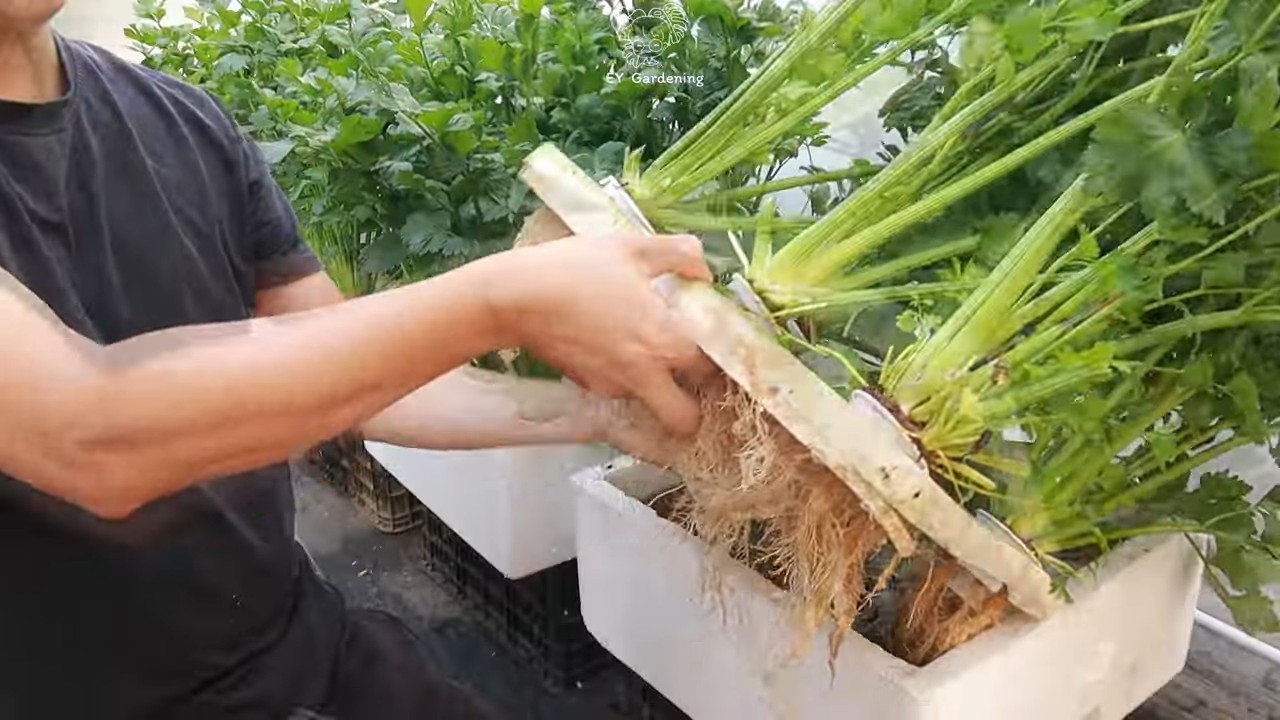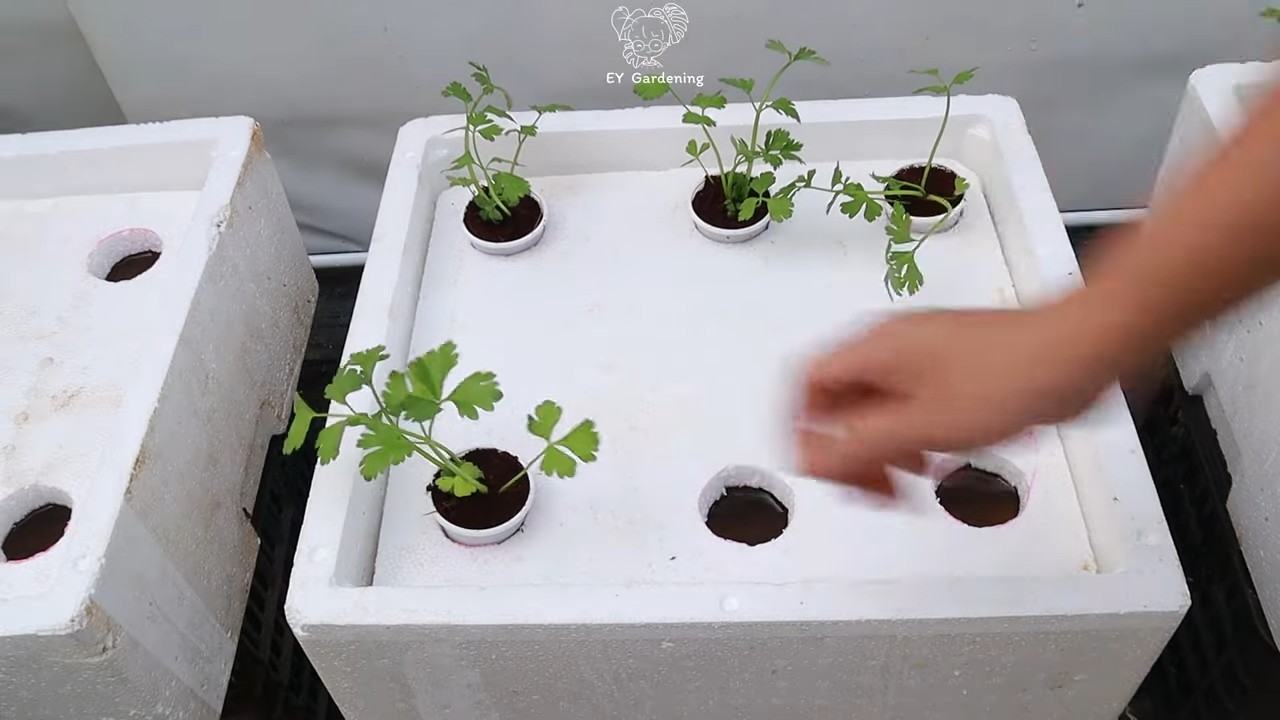Hydroponic celery home setup might sound intimidating, but trust me, it’s easier than you think! Forget battling garden pests and unpredictable weather – we’re bringing the farm indoors! For centuries, humans have sought innovative ways to cultivate food, from ancient terraced gardens to modern greenhouses. Now, you can join this tradition with a simple, space-saving hydroponic system right in your own home.
Have you ever dreamt of snipping fresh celery for your salads or soups without a trip to the grocery store? Or maybe you’re tired of buying celery that wilts within days of bringing it home? That’s where this DIY guide comes in. I’m going to show you how to create your very own hydroponic celery home setup, allowing you to enjoy crisp, flavorful celery year-round.
This isn’t just about convenience; it’s about taking control of your food source and embracing a sustainable lifestyle. Plus, it’s a fun and rewarding project that anyone can tackle, regardless of their gardening experience. So, let’s dive in and discover the secrets to growing delicious celery hydroponically!

DIY Hydroponic Celery: From Kitchen Scrap to Crunchy Stalks!
Hey there, fellow plant enthusiasts! Ever wondered if you could grow your own celery without all the soil and fuss? Well, I’m here to tell you that you absolutely can! This guide will walk you through setting up a simple hydroponic system to regrow celery from those leftover bases you usually toss in the compost. Get ready for some fresh, crunchy celery right from your kitchen!
What You’ll Need
Before we dive in, let’s gather our supplies. Don’t worry, you probably have most of this stuff lying around already!
* **Celery Base:** The star of the show! Save the base of your celery bunch (about 2-3 inches from the bottom) after you’ve used the stalks.
* **Shallow Container:** A plastic container, bowl, or even a repurposed yogurt tub will work. Make sure it’s wide enough to comfortably hold the celery base.
* **Water:** Tap water is fine, but letting it sit out for 24 hours to dechlorinate is even better.
* **Toothpicks (Optional):** These can help suspend the celery base if your container is too deep.
* **Grow Lights (Optional but Recommended):** Celery needs plenty of light, so a grow light can significantly boost growth, especially if you don’t have a sunny windowsill.
* **Hydroponic Nutrients (Optional):** While not strictly necessary for the initial regrowth, adding a diluted hydroponic nutrient solution will provide essential nutrients for healthier and faster growth. I recommend a balanced formula.
* **Small Net Pots (Optional):** If you want to transition your celery to a more permanent hydroponic setup later, net pots will be useful.
* **Growing Medium (Optional):** Coco coir, perlite, or rockwool are great options for a more established hydroponic system.
* **Larger Container (Optional):** For transplanting to a larger hydroponic system.
Phase 1: Regrowing from the Base
This is where the magic begins! We’re going to coax that celery base into sprouting new growth.
1. **Prepare the Celery Base:** After you’ve used the celery stalks, rinse the base thoroughly under cool water to remove any dirt or debris. Gently peel away any outer, damaged layers.
2. **Place in Water:** Fill your shallow container with about an inch of water. The water level should just cover the bottom of the celery base, but not submerge the entire thing. If your container is too deep, use toothpicks inserted around the sides of the celery base to suspend it at the correct height.
3. **Find a Sunny Spot:** Place the container on a windowsill that receives plenty of indirect sunlight. Direct sunlight can scorch the new growth, so avoid that. If you don’t have a sunny windowsill, use a grow light. Position the light a few inches above the celery base and leave it on for about 12-16 hours a day.
4. **Change the Water Regularly:** This is crucial! Change the water every 1-2 days to prevent bacteria and algae growth. Fresh water provides oxygen and keeps things clean.
5. **Observe and Wait:** Within a few days to a week, you should start to see small, pale green leaves emerging from the center of the celery base. This is a sign that your celery is regrowing!
Phase 2: Encouraging Growth
Now that we have new growth, let’s help our celery thrive!
1. **Continue Changing the Water:** Keep up the regular water changes. Clean water is key to healthy growth.
2. **Introduce Nutrients (Optional):** Once the new leaves are a few inches tall, you can start adding a diluted hydroponic nutrient solution to the water. Follow the instructions on the nutrient package, but start with half the recommended strength to avoid burning the delicate new roots.
3. **Maintain Adequate Light:** Ensure your celery continues to receive plenty of light, either from a sunny windowsill or a grow light.
4. **Monitor Root Development:** As the celery grows, you’ll start to see roots emerging from the bottom of the base. These roots will be white and thin.
Phase 3: Transplanting (Optional)
If you want to grow your celery to full size, you’ll need to transplant it to a larger hydroponic system. This step is optional, but it will allow your celery to reach its full potential.
1. **Prepare Your Hydroponic System:** There are many different types of hydroponic systems you can use, but a simple Kratky system is a great option for beginners. This involves placing the celery in a net pot filled with a growing medium like coco coir or perlite, and suspending the net pot in a container filled with nutrient solution.
2. **Gently Remove the Celery:** Carefully remove the celery base from the water. Be gentle to avoid damaging the roots.
3. **Place in Net Pot:** Place the celery base in the net pot, making sure the roots are surrounded by the growing medium.
4. **Suspend in Nutrient Solution:** Place the net pot in the larger container filled with nutrient solution. The bottom of the net pot should be submerged in the solution, but the celery base should not be completely submerged.
5. **Maintain Optimal Conditions:** Continue to provide plenty of light and change the nutrient solution regularly. Monitor the pH of the nutrient solution and adjust as needed. The ideal pH for celery is between 6.0 and 6.8.
Troubleshooting
Even with the best intentions, things can sometimes go wrong. Here are a few common problems and how to fix them:
* **No Growth:** If you’re not seeing any new growth after a week or two, make sure the celery base is getting enough light and that you’re changing the water regularly. Also, check the temperature. Celery prefers temperatures between 60-70°F (15-21°C).
* **Rotting Base:** If the celery base starts to rot, it’s likely due to bacteria or fungus. This is usually caused by stagnant water. Make sure you’re changing the water frequently. You can also try adding a small amount of hydrogen peroxide to the water to kill any harmful microorganisms.
* **Yellowing Leaves:** Yellowing leaves can be a sign of nutrient deficiency. Try adding a diluted hydroponic nutrient solution to the water. It can also be a sign of too much direct sunlight.
* **Slow Growth:** Slow growth can be caused by a variety of factors, including insufficient light, nutrient deficiencies, or improper pH. Make sure you’re providing optimal conditions for your celery.
Tips for Success
Here are a few extra tips to help you succeed with your hydroponic celery project:
* Start with a Healthy Celery Base: Choose a celery bunch with a firm, healthy base. Avoid bases that are soft, discolored, or have signs of rot.
* Be Patient: Regrowing celery takes time. Don’t get discouraged if you don’t see results immediately.
* Experiment with Different Nutrients: There are many different hydroponic nutrient solutions available. Experiment with different formulas to find one that works best for your celery.
* Keep it Clean: Maintaining a clean environment is crucial for preventing disease and promoting healthy growth. Regularly clean your containers and equipment.
* Enjoy the Process: Growing your own food is a rewarding experience. Take the time to enjoy the process and learn from your mistakes.
Beyond the Basics: Advanced Hydroponic Celery
Once you’ve mastered the basics of regrowing celery from a base, you can explore more advanced hydroponic techniques. Here are a few ideas:
* Deep Water Culture (DWC): This involves suspending the celery roots directly in a nutrient solution that is constantly aerated with an air pump and air stone.
* Nutrient Film Technique (NFT): This involves flowing a thin film of nutrient solution over the celery roots.
* Ebb and Flow (Flood and Drain): This involves periodically flooding the growing medium with nutrient solution and then draining it away.
These advanced techniques can provide even faster and more efficient growth, but they also require more equipment and expertise.
So there you have it! A comprehensive guide to growing your own hydroponic celery. It’s a fun, easy, and rewarding project that anyone can do. Happy growing! I hope you enjoy your homegrown celery!

Conclusion
So, there you have it! Transforming your kitchen into a mini-hydroponic farm for celery is not only achievable but also incredibly rewarding. We’ve walked you through the simple steps, highlighting the ease and accessibility of this DIY project. Forget those wilted, flavorless celery stalks from the grocery store. With this method, you’re guaranteed crisp, vibrant, and intensely flavored celery, ready to elevate your salads, soups, and snacks.
But why is this hydroponic celery home setup a must-try? Beyond the superior taste and freshness, it’s about taking control of your food source. You know exactly what’s going into your celery – no pesticides, no hidden chemicals, just pure, unadulterated goodness. It’s also a fantastic way to reduce food waste. Instead of tossing those celery bases, you’re giving them a new lease on life, turning kitchen scraps into a thriving source of fresh produce.
The beauty of this method lies in its adaptability. Feel free to experiment with different nutrient solutions to find what works best for your celery. You can also try growing different varieties of celery, from the classic Pascal to the more delicate Chinese celery. Consider adding companion plants like basil or parsley to your hydroponic setup for a more diverse and fragrant garden.
Don’t be afraid to get creative with your setup. While we’ve outlined a simple water bottle method, you can easily adapt it to larger containers or even invest in a small hydroponic system for a more automated approach. The possibilities are endless!
We understand that venturing into the world of hydroponics can seem daunting at first, but trust us, it’s easier than you think. The initial setup requires minimal effort, and the ongoing maintenance is surprisingly low. The satisfaction of harvesting your own fresh celery is well worth the small investment of time and resources.
We wholeheartedly encourage you to give this hydroponic celery home setup a try. It’s a fun, educational, and ultimately delicious way to connect with your food and embrace a more sustainable lifestyle.
And most importantly, we want to hear about your experiences! Share your photos, tips, and challenges in the comments below. Let’s build a community of hydroponic celery enthusiasts and learn from each other. What nutrient solutions did you find most effective? What challenges did you encounter, and how did you overcome them? Your insights could be invaluable to other aspiring hydroponic gardeners. So, grab those celery bases, gather your supplies, and get growing! We can’t wait to see your hydroponic celery gardens flourish.
Frequently Asked Questions (FAQ)
What exactly is hydroponics, and is it difficult?
Hydroponics is a method of growing plants without soil, using water-based nutrient solutions. Instead of relying on soil to provide nutrients, the plants receive everything they need directly from the water. While it might sound complicated, it’s actually quite simple, especially for beginners. Our hydroponic celery home setup is designed to be easy and accessible, even if you have no prior experience with hydroponics. The difficulty level is low, and the rewards are high!
What kind of celery is best for hydroponic growing?
You can regrow any type of celery using this method. However, the most common and readily available variety, Pascal celery, works exceptionally well. Chinese celery, with its thinner stalks and more intense flavor, is also a great option. Experiment with different varieties to see which one you prefer. The key is to start with a healthy celery base that shows signs of new growth.
What kind of water should I use?
Tap water is generally fine for hydroponic celery growing, but it’s best to let it sit out for 24 hours to allow chlorine to dissipate. If your tap water is heavily chlorinated or contains other additives, consider using filtered water or rainwater. Avoid using distilled water, as it lacks the essential minerals that plants need.
What kind of nutrient solution do I need?
A balanced hydroponic nutrient solution is crucial for healthy celery growth. You can find commercially available nutrient solutions specifically formulated for leafy greens. Follow the instructions on the packaging carefully, as over-fertilizing can be harmful to your plants. Alternatively, you can create your own nutrient solution using readily available ingredients. Researching DIY hydroponic nutrient recipes online can provide you with various options. Remember to monitor your celery for signs of nutrient deficiencies, such as yellowing leaves, and adjust the nutrient solution accordingly.
How often should I change the water and nutrient solution?
It’s essential to change the water and nutrient solution regularly to prevent the buildup of algae and bacteria. Aim to change the solution every 1-2 weeks, depending on the size of your container and the growth rate of your celery. When changing the solution, gently rinse the roots of the celery to remove any debris.
How much light does hydroponic celery need?
Celery needs plenty of light to thrive. Ideally, provide at least 6-8 hours of direct sunlight per day. If you don’t have access to enough natural light, you can supplement with artificial grow lights. LED grow lights are a great option, as they are energy-efficient and provide the full spectrum of light that plants need.
How long does it take to grow celery hydroponically?
The time it takes to grow celery hydroponically depends on various factors, including the variety of celery, the amount of light, and the nutrient solution. Generally, you can expect to see significant growth within 2-3 weeks. You can start harvesting individual stalks of celery as needed once they reach a desirable size.
Can I grow celery from seed hydroponically?
Yes, you can grow celery from seed hydroponically, but it requires a bit more patience and effort. Start by germinating the seeds in a seed starting tray or rockwool cubes. Once the seedlings have developed a few true leaves, you can transplant them into your hydroponic system.
What are some common problems with hydroponic celery and how can I fix them?
Some common problems with hydroponic celery include algae growth, nutrient deficiencies, and pest infestations. To prevent algae growth, keep your container clean and opaque. If you notice algae, clean the container thoroughly and consider adding a small amount of hydrogen peroxide to the water. Nutrient deficiencies can be addressed by adjusting the nutrient solution. Pest infestations can be treated with organic pesticides or by introducing beneficial insects.
Is hydroponic celery as nutritious as soil-grown celery?
Yes, hydroponic celery can be just as nutritious as soil-grown celery, and in some cases, even more so. By providing the plants with a perfectly balanced nutrient solution, you can ensure that they receive all the essential vitamins and minerals they need. The taste and texture of hydroponic celery are also often superior to that of soil-grown celery.
Can I use this method to grow other vegetables?
Absolutely! While this article focuses on celery, the principles of hydroponics can be applied to a wide variety of vegetables, herbs, and fruits. Lettuce, spinach, kale, basil, mint, and strawberries are just a few examples of plants that thrive in hydroponic systems. Experiment with different plants and find what works best for you.
How do I know when my celery is ready to harvest?
Your celery is ready to harvest when the stalks are thick, crisp, and have reached a desirable size. You can harvest individual stalks as needed, or you can harvest the entire plant at once. To harvest, simply cut the stalks at the base of the plant.
What can I do with my hydroponically grown celery?
The possibilities are endless! Use your fresh, flavorful celery in salads, soups, stews, smoothies, and snacks. It’s also a great addition to stir-fries and other cooked dishes. You can even use the celery leaves to make pesto or add flavor to stocks and broths.
How do I prevent root rot in my hydroponic celery?
Root rot is a common problem in hydroponic systems, caused by a lack of oxygen around the roots. To prevent root rot, ensure that your water is well-oxygenated. You can use an air pump and air stone to increase oxygen levels. Also, avoid overwatering and ensure that your container has adequate drainage. Regularly inspect the roots for signs of rot, such as brown or slimy roots. If you notice root rot, remove the affected roots and treat the remaining roots with a fungicide.




Leave a Comment